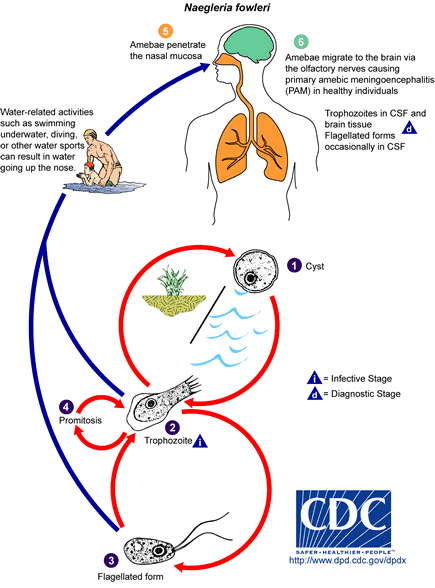Health officials in Ohio are reporting a fatal case of primary amebic mengioencephalitis, or PAM, which is caused by the infection with the free-living amoeba, Naegleria fowleri.

In a statement to Outbreak News Today, Franklin County Public Health Director of Communication, Mitzi Kline said, “An 18 year old Franklin County female has died from a confirmed cased of primary amebic mengioencephalitis. The amoeba, Naegleria fowleri, is commonly referred to as a brain eating amoeba. The exposure occurred while she was traveling out of state. Cases are very rare. There have been 37 reported infections in the U.S. in the ten years from 2006 – 2015.
“The health jurisdiction where the infection occurred is working on a statement with CDC that will be released today.”
Local media have identified the victim as Lauren Seitz, a student at Westerville South High School located northeast of Columbus, OH.
Naegleria fowleri is a relatively rare, pathogenic amoeba found in warm or hot freshwater like lakes, rivers and hot springs. It is also possible to get it from dirty unchlorinated or under-chlorinated swimming pools. This parasite is found worldwide and in the United States, it is found mainly in the southern-tier states.
People typically get it by swimming, jumping or playing in freshwater and get the water up their nose. From there the parasite travels to the brain and spinal cord and necrotizes or basically eats brain tissue. The disease is known as primary amoebic meningoencephalitis (PAM) and it has a very rapid progression. Typical symptoms may start after a day or two; headache, fever, nausea and vomiting. Later symptoms may include seizures, irrational behavior, hallucinations and finally coma and death. The course of the disease typically last about a week. Because the symptoms are very similar to bacterial meningitis, PAM may not even be considered in the diagnosis.
Fortunately, it’s a pretty rare disease, with only approximately 30+ cases in the past decade. Unfortunately, treatment is largely unsuccessful with a fatality rate at 98 percent.
Related:
- Rio Olympics 2016: Travel health advice from WHO
- Ireland measles outbreak: 22 cases in Kerry
- Minnesota: Nine Salmonella cases linked to newly hatched poultry bought at feed stores


I cant believe people think this is a natural occurring entity. This is more man-made stuff. The drug companies help create illnesses and diseases to put in the system. Then they throw drugs at us to “cure” the problem. People die because of this. When will everyone wake up and see the TRUTH about the world? GOD did not put all this stuff on Earth. Man continues to rape and destroy all of humanity and life.
You are really a big part of the problem in this country if you think this particular comment is relative in a naturally occurring bacteria. You are clueless!